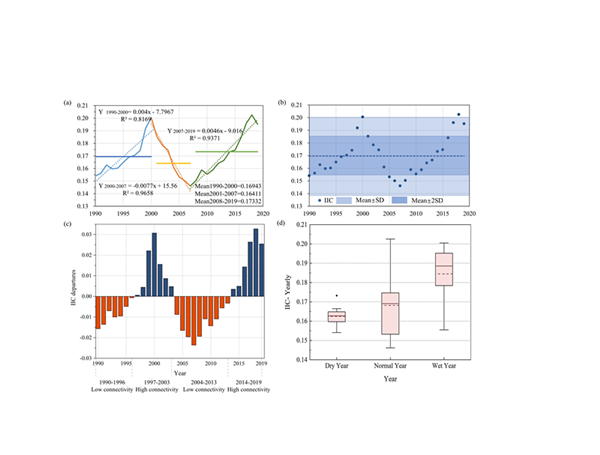Study Reveals Hydrological Connectivity and Its Water-related Effects in Arid Inland River Basins
2022-12-19
The dynamic changes and transitions of hydrological connectivity will lead to the changes of hydrodynamic conditions of rivers and lakes, which will have a linkage effect on water quality, water ecology, water environmental conditions and trigger feedback effects, thus directly affecting the quality of water environment, ecological safety of wetlands and ecosystem stability, eventually leading to the degradation and loss of structure and function of river and lake systems.
The fragmented hydrological structure of inland river in arid zones is sensitive to the dynamic changes of hydrological connectivity, and with the increase of climate change and human activities, the relationship between hydrological connectivity and water environment becomes more and more complex, which has been neglected in current studies of hydrological processes in arid zones.
Based on the last thirty years of measured water quality data and hydrometeorological data of Bosten Lake, Xinjiang, researchers from Xinjiang Institute of Ecology and Geography, Chinese Academy of Sciences, assessed the hydrological connectivity dynamics and its influence factors in the Bosten basin from 1990 to 2019, and revealed the influence of hydrological connectivity dynamics on water quality.
The results show that from 1990 to 2019, the hydrological connectivity index (IIC) of the Bosten Lake basin shows an increasing trend but is relatively low overall (between 0 and 0.2), and the connectivity is higher in wet periods and oasis areas. The IIC is significantly positively correlated (p< 0.05) with precipitation (PREC), and water resources in the inland river basin of the arid zone are formed in mountainous areas, while in plain areas precipitation is scarce and almost non-hydrologically significant except for extreme rainstorms, which makes it difficult to recharge rivers, resulting in a significant negative correlation between hydrological connectivity and actual evapotranspiration (ETa) (p<0.05). Higher hydrological connectivity has a contributing effect on improving water quality, and hydro-chemical concentrations are lower during periods of high hydrological connectivity, and about 75% of the attainment period of the main pollution indicators (TDS, COD, TN) in Bosten Lake occurred during periods of high hydrological connectivity. The study systematically assessed the relationship between hydrological connectivity and water environment quality, which provides a powerful support for sustainable development and climate change response in the Bosten basin.
The related results were published in the journal of Remote Sensing named as "Hydrological Connectivity Improves the Water-Related Environment in a Typical Arid Inland River Basin in Xinjiang, China ".
Link to article: https://www.mdpi.com/2072-4292/14/19/4977/htm

Fig. 1. (a) Time series, trends and phases of yearly-IIC changes in the Bosten Lake basin from 1990 to 2019; (b) dispersion of yearly-IIC in the Bosten Lake basin from 1990 ~ 2019; (c) fluctuations of IIC based on the 30-year average from 1990 - 2019; (d) distribution of yearly-IIC index in different years.

Fig. 2. (a) Box line diagram of 8 water quality indicators during high connectivity (green area) and low connectivity (yellow area), respectively; (b) Box line diagram of 8 water quality indicators during May-October, respectively, where May is spring (red), June-August is summer (green), and September-October is autumn (blue).
Contact: LIU Jie, Xinjiang Institute of Ecology and Geography
E-mail: liujie@ms.xjb.ac.cn



